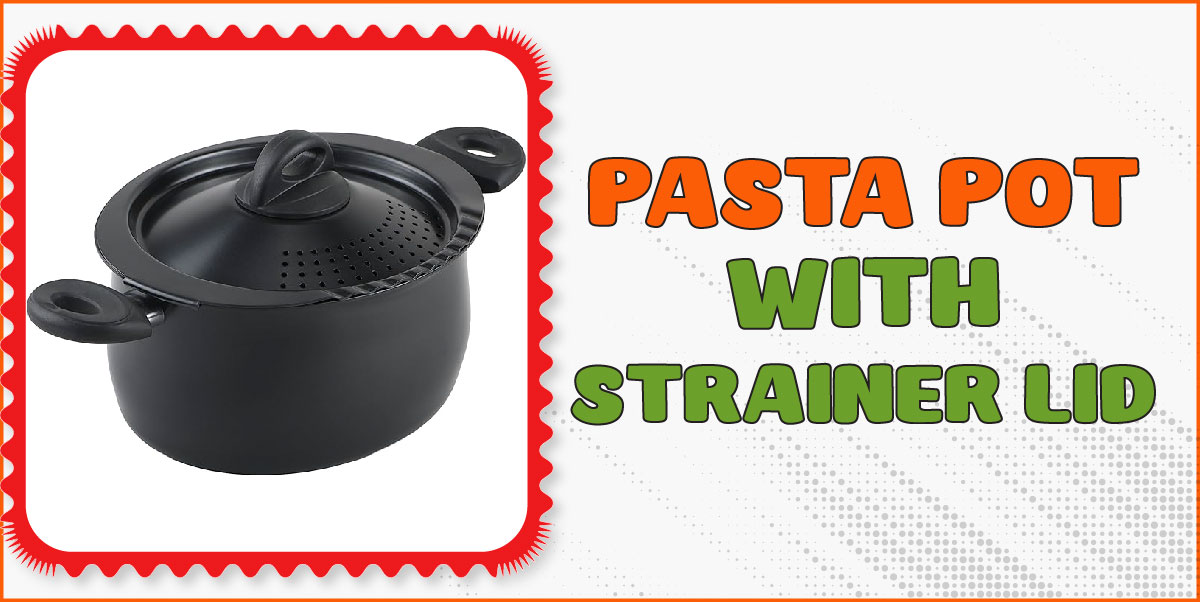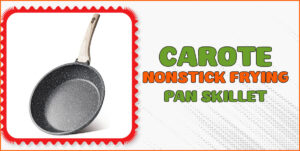I used to juggle a wobbly colander over the sink, splashing hot water everywhere, until I finally got a pasta pot with a strainer lid. It made a huge difference. As someone who cooks pasta at least twice a week (yes, I’m that person), I’ve tried it all, pasta strainers for pots, pasta cooking baskets, even enamelled cast iron.
I’ve made plenty of messes and learned what works. In this guide, I’ll share what these pots are, why they help, and how to pick the right one. If you’ve ever wondered what size pot for pasta or how to use a pasta strainer without making a mess, I’ve got you covered. Let’s dive in, This little switch can make dinner much easier.
Table of Contents
What Is a Pasta Pot with a Strainer Lid?
A pasta pot with a strainer lid is just what it sounds like: a pot and strainer in one. You boil your pasta like normal, then pour the water without a colander. The lid stays locked in place, so nothing slips or spills.
The first time I used one, I thought, Why didn’t I do this sooner? No more awkward lifts over the sink. No more pasta slipping into the drain. You just tilt, drain, and you’re done.
Most of these pots come with smart features. You’ll often see a locking lid, pour spouts, and handles that stay cool. Some lids even have different-sized holes for thick or thin pasta. It’s simple, but smart.
Compared to the old pot-and-colander setup, this is easier and safer. Less steam in your face. Fewer dishes in your sink. And fewer burns on your hands- I’ve been there.
If you’re looking for a cooking pot with a strainer, a pasta saucepan with a strainer lid, or just a way to make dinner less stressful, this is it. It’s one of those tools you don’t think you need until you try it, and then you never go back.
Why Use a Pasta Pot with a Strainer Lid?
Let’s be real, pouring a heavy pot of boiling pasta into a colander is awkward at best and dangerous at worst. I used to do the “sink shuffle,” trying not to spill noodles or steam my face off. Then came the strainer lid. Game changer.
With one of these pots, you just lock the lid, tilt it slightly, and drain. That’s it. No juggling. No pasta avalanche. Just smooth, steady draining, like it should be.
It’s perfect for small kitchens. If you don’t have much counter space (hi, tiny apartment life), ditching the extra colander frees up room. Plus, there’s less to wash. One pot. One lid. Done.
And it’s not just for pasta. I use mine to boil eggs, steam veggies, and even rinse rice. It’s super versatile. Think of it as your go-to for any “boil and drain” job.
Cleanup is easier, too. Less splashing means fewer messes. And because the pasta never leaves the pot, there’s less chance of it sticking to the sink or slipping into the drain (yes, I’ve cried over lost ravioli).
If you’re someone who cooks dinner after work and just wants less fuss, this pot has your back. It’s one of those little upgrades that quietly change your whole routine. You’ll wonder why you didn’t get one sooner.
What Size Pot Do You Need for Pasta?
If you’ve ever tried boiling spaghetti in a small pot, you know the struggle, half the noodles stick out, and you end up poking them down like whack-a-mole. Not ideal.
Here’s the deal. Pasta needs space. Lots of it. When you drop it into boiling water, it expands and needs to move around to cook evenly. If the pot’s too small, it clumps. If it’s too big? That’s just more water (and time) than you need.
For one or two people, a 4-quart pot can work, especially for quick dinners or small shapes like macaroni. But I’ve found even then, a 6-quart gives you breathing room. Less chance of boiling over. Easier to stir.
For families or batch cooking, go for an 8-quart. That’s what I use when I’m making pasta for meal prep or a big Sunday dinner. It holds a full pound of pasta without overflowing. And if you’re like me and always want leftovers (hello, next-day pasta salad), bigger is better.
Also, if you’re adding extras, like boiling pasta and broccoli together, go bigger. The more food, the more space you’ll need.
How to Use a Pasta Strainer Lid (Safely)
Okay, real talk? The first time I used a pasta pot with a strainer lid, I was nervous. I kept picturing the pot slipping, hot water flying, pasta everywhere. But once I got the hang of it, it felt easy and way safer than juggling a full colander over the sink.
1. Boil your pasta like usual.
Fill the pot with water, toss in a pinch of salt, and bring it to a boil. Add your pasta and stir once or twice so it doesn’t stick.
2. Lock the lid in place.
Most pasta pots with strainer lids have little notches or twist locks. Make sure it’s fully secured before draining. If it feels loose, double-check it. This is key.
3. Grip the handles firmly.
Use dry kitchen towels or silicone oven mittens. Wet towels are slippery (learned that the hard way). Grip both handles tightly, one on each side.
4. Slowly tilt the pot over the sink.
Here’s the magic moment. Angle the pot gently so the water drains through the strainer lid. Go slow. If you rush, the pasta can bunch up and block the holes.
5. Give it a shake if needed.
Sometimes the pasta holds onto extra water. A gentle little wiggle helps drain it all.
Pro Tips to Stay Safe and Clean
- Use a deep sink if you have one. More space means fewer splashes.
- Don’t overfill the pot. Leave room for the water to bubble without spilling.
- Watch the steam. Steam burns sneak up fast. Keep your hands above the lid, not over the holes.
- Clean the lid after each use. Pasta starch can build up and clog the holes. I just scrub it gently with a sponge and warm, soapy water.
Can You Boil Pasta in Enamelled Cast Iron?
Let me tell you, I’ve done it. One night, all my regular pots were in the dishwasher, and my trusty enamelled cast iron Dutch oven was the only clean option. I hesitated, was it okay to boil pasta in it? Turns out, it worked beautifully with some caveats.
It Holds Heat Like a Champ
Enamelled cast iron heats evenly and stays hot for a long time. That’s great for slow cooking, but when boiling pasta, it also means the water takes longer to heat up. If you’re in a rush, this can be a little annoying.
It’s Heavy, So Be Careful When Draining
These pots are no joke when it comes to weight. Add boiling water and pasta, and suddenly you’re lifting a small boulder over your sink. I needed two hands and dry towels for grip.
Enamel Needs a Little TLC
Enamelled interiors are non-reactive and easy to clean, but they don’t love sudden temperature changes. Don’t crank the heat too high too fast, and avoid metal utensils that might chip the surface.
When I Use Mine for Pasta
I use my enamelled cast iron pot when I’m making a one-pot pasta dish, like creamy stovetop mac and cheese. The even heat helps the sauce stay smooth, and cleanup is easy. But I still reach for my lightweight pot with the locking strainer lid for plain pasta with a quick drain. Less drama, less arm workout.
What I Like
I’ve used a few different pasta pots over the years, but this one with the built-in strainer lid has been a total game-changer. Here’s what I genuinely enjoy about it:
- No more juggling colanders. I used to struggle holding a heavy pot while trying to pour into a colander. Now, I just twist the lid and drain—it’s so easy and safe.
- Fewer dishes to clean. I love that I don’t need to pull out an extra strainer. One less thing to wash after dinner? Yes, please.
- Even heat distribution. Pasta cooks evenly, and I don’t get those weird undercooked bites anymore. It saves time and reduces waste.
- Sturdy and well-balanced. It doesn’t wobble on the stove, even when full. That gives me peace of mind when cooking around kids.
- Great for more than just pasta. I’ve used it for boiling potatoes, blanching veggies, and even steaming dumplings. It’s become my go-to pot.
What Could Be Better
Nothing’s perfect, right? While I love my pasta pot with strainer lid, here are a few little things I think could be improved, just being real with you:
- The lid can get hot. You’ll need a mitt to twist and drain safely. A little silicone grip on the handle would make a big difference.
- It takes up space. It’s a bit bulky for smaller kitchens. I wish it nested better with other pots for easy storage.
- Strainer holes could be finer. Tiny pasta like orzo can slip through. I’ve learned to be gentle when draining those smaller shapes.
- Still, none of these are deal-breakers. They’re just little quirks I’ve learned to work with, and I’d buy it again in a heartbeat.
My Personal Experience
I’ve been using a pasta pot with a strainer lid for over two years now. It’s held up beautifully, and honestly, I don’t see myself going back to a regular pot and colander combo. Here’s what stands out most in my daily cooking:
Design
This pot is smartly designed for real-life kitchens.
The strainer lid locks in place with a simple twist, which means I don’t have to worry about steam burns or spilling noodles into the sink. The handles are wide and comfortable, even with oven mittens on. Plus, it just looks sleek on the stove. The whole setup feels like it was made by someone who cooks.
Performance
It performs better than I expected, even after regular use.
Water heats up quickly, pasta cooks evenly, and draining is smooth. I don’t get that boiling-over mess anymore because of the built-in steam vents. It’s ideal for busy weeknights when I just want dinner done fast and without drama. And I’ve noticed I use less water because I’m not trying to overcompensate for the lack of a colander.
Build Quality
The quality is solid, no flimsy parts or cheap finishes.
After two years, it still looks almost new. No warping, no rust, and no peeling. I’ve dropped it (oops), scrubbed it, and used it nearly every week. It’s sturdy without being too heavy, and the metal hasn’t discolored or dented. Compared to other brands I’ve used, this one stands out in terms of longevity and craftsmanship.
Final Thoughts
Enameled cast iron is heavy, especially when full of boiling water and pasta. Lifting and draining it takes two hands and a strong grip. This isn’t the pot you want to tilt quickly over the sink. If your pasta pot has a strainer lid and stays lighter, that’s a big win for daily cooking.
Read More: Zojirushi NS ZCC10 Rice Cooker
FAQ
What is a pasta pot with a strainer lid?
It’s a pot with a built-in lid that strains water as you pour, no separate colander needed. Makes draining pasta fast and mess-free.
Is a pasta pot with a strainer lid worth it?
Yes! It saves time, reduces dishes, and makes pasta night easier. Learn more about how it can simplify your kitchen routine.
Can I use a pasta pot with a strainer lid for other foods?
Absolutely. It’s great for boiling veggies, potatoes, or eggs. Learn more about its everyday versatility in the kitchen.
Are pasta pots with strainer lids safe to use?
Yes, when used properly. Just hold the handles securely while pouring. Learn more safety tips in the full guide.
What size pasta pot with a strainer lid should I buy?
Go for 6-8 quarts for families, or 4-5 quarts for smaller meals. Learn more about sizing and which one fits your needs best.






Pingback: Olive Oil Sprayer Review: Smart, Simple & Surprising - KitchArranged – Easy Storage & Furniture Tips For Every Kitchen